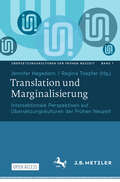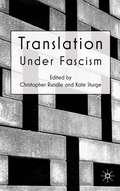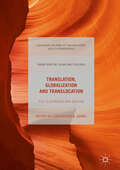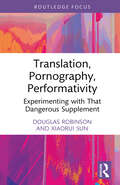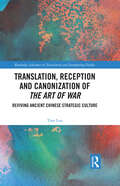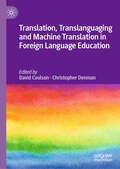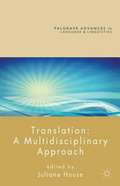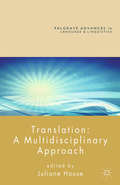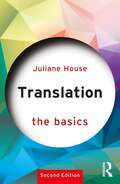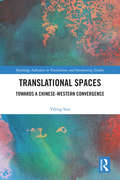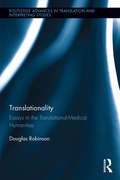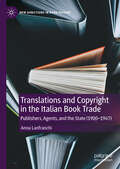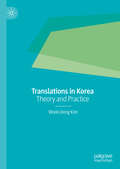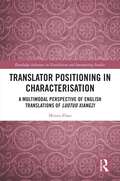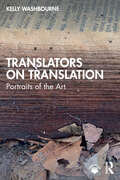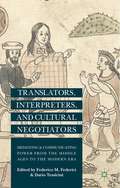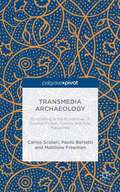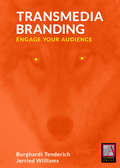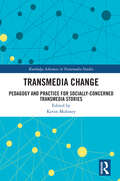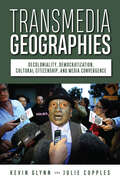- Table View
- List View
Translation on Display: Multilingual Texts in Multimodal Museum Space (Routledge Advances in Translation and Interpreting Studies)
by Min-Hsiu LiaoThis book foregrounds the role of translated texts in the study of the assemblages of semiotics resources in museums, important cultural institutions which encompass such sites as exhibition spaces, galleries, heritage sites, castles, and memorials.The book is organised in order of units of space, moving from smaller spaces to larger ones, with each chapter focused on an “act” enacted by the space, performed by the semiotic systems at work in these spaces and their visitors as social agents looking, feeling, moving, and living in them. In examining how translated texts interact with objects, spatial layout, surroundings, and visitors in the museum settings, the volume offers a way forward for better understanding the theoretical foundations of museum translation and the analytical tools available for examining textual data gathered from these spaces.This book will be of interest to scholars in translation studies, tourism studies, heritage studies, and cultural studies.
Translation und Marginalisierung: Intersektionale Perspektiven auf Übersetzungskulturen der Frühen Neuzeit (Übersetzungskulturen der Frühen Neuzeit #7)
by Regina Toepfer Jennifer HagedornÜbersetzungen spiegeln und bestätigen die Normen der zielkulturellen Mehrheitsgesellschaft und ihrer machthabenden Instanzen, wohingegen Anliegen von Minderheiten meist unberücksichtigt bleiben. Diesen oft übersehenen Zusammenhang zwischen Translation und Marginalisierung leuchtet der interdisziplinäre Open Access-Band für die Frühe Neuzeit systematisch aus und rückt jene Menschen, Figuren und Gruppen in den Mittelpunkt, die in doppelter oder mehrfacher Weise minderprivilegiert sind. In fünfzehn Kapiteln werden intersektionale Perspektiven auf die frühneuzeitlichen Übersetzungskulturen eröffnet und hierarchisierende Verfahren in Theorie, Praxis und Forschung offengelegt. Das Untersuchungsspektrum reicht von frühneuzeitlichen Übersetzungen antiker Epen und mittelalterlicher Kreuzzugsliteratur über frühneuzeitliche Reiseberichte aus Brasilien und dem Senegal bis hin zum rumänischen Kinder- und Jugendbuch und zur sogenannten Gipsy-Musik. Genderspezifische, heteronormative und koloniale Diskriminierungspraktiken sind verschränkt und verstärken sich wechselseitig. Translations reflect and affirm the norms of the target culture’s mainstream society and its power holders; the concerns of minorities, however, go largely unheeded. This interdisciplinary open-access volume illuminates the often-overlooked relationship between translation and marginalization while focusing on persons, characters, and groups that are underprivileged in two or more ways. Its fifteen chapters introduce intersectional perspectives on Early Modern translation cultures and shed light on hierarchizing processes in theory, practice, and research. The objects of study range from Early Modern translations of classical epic and medieval crusade literature and accounts of travel in Brazil and Senegal dating from the same period to Romanian children’s and juvenile literature and so-called gipsy music. Gender-specific, heteronormative, and colonial discrimination practices prove to intertwine and mutually amplify one another. Dies ist ein Open-Access-Buch.
Translation under Fascism
by Christopher Rundle Kate SturgeThe history of translation has focused on literary work but this book demonstrates the way in which political control can influence and be influenced by translation choices. New research and specially commissioned essays give access to existing research projects which at present are either scattered or unavailable in English.
Translation, Globalization and Translocation
by Concepción B. GodevThis book examines the spaces where translation and globalization intersect, whether they be classrooms, communities, or cultural texts. It foregrounds the connections between cultural analysis, literary critique, pedagogy and practice, uniting the disparate fields that operate within translation studies. In doing so, it offers fresh perspectives that will encourage the reader to reappraise translation studies as a field, reaffirming the directions that the subject has taken over the last twenty years. Offering a comprehensive analysis of the links between translation and globalization, this ambitious edited collection will appeal to students and scholars who work in any area of translation studies.
Translation, Pornography, Performativity: Experimenting with That Dangerous Supplement (Routledge Advances in Translation and Interpreting Studies)
by Douglas Robinson Xiaorui SunRobinson and Sun’s book goes in search of the neglected metaphorics of translation in pornography using poststructuralist rethinkings and reframings of porn (and masturbation) from Jacques Derrida to Judith Butler.In his 1684 “Essay on Translated Verse,” the Earl of Roscommon attacked “want of decency” in translation metaphorically by comparing it to picking up prostitutes in the park (“raking the park for stews”) instead of hanging out with “troops of faultless nymphs.” Sex work, and the graphic representation of sex work that Nathaniel Butler was the first to call “pornography” in print in 1638, is used as a metaphor for non-normative translation, which in Robinson and Sun’s hands becomes experimental translation.En route to that goal, the authors take us through Butler on performativity and resistance, Derrida on supplementarity and iterability, and Haun Saussy’s innovative application of Derridean citationality to the use of a target-cultural “sponsor” or “bondsman” for translation. They take detours through Charles Baudelaire’s “Une charogne” and J.G. Ballard’s “The Drowned Giant.”They deal with the performativity of pornography (and translatography) in Part I, the “unnatural” iterability of masturbation (and translation) in Part II, and experimental translation in Part III.The theory-littered path this book takes through the metaphorics of translation will be of interest to scholars and students of translation studies, especially experimental translation and translation theory, but also media scholars interested in the philosophical complexities of performativity.
Translation, Reception and Canonization of The Art of War: Reviving Ancient Chinese Strategic Culture (Routledge Advances in Translation and Interpreting Studies)
by Tian LuoThe Art of War by Sun Tzu is an ancient yet invaluable Chinese military classic that is still relevant today. This book presents a systematic and in-depth investigation into the translation and reception of The Art of War in the western strategic culture. Aided by three self-built corpora, this study adopts a mixed method including both qualitative and quantitative analysis, and aking takes both the core text and its paratexts of The Art of War into consideration. This study highlights the significance of proper approaches to translating culture in the core text and effective measures of culture reconstruction in paratexts. It is revealed that the translated Sun Tzu has undergone three major stages before it is gradually welcomed and re-canonized in western discourse. The findings bring into light the multiple factors that contribute to the incorporation of Sun Tzu’s strategic wisdom into western culture. For scholars interested in translation studies, (critical) discourse analysis as well as strategic studies, this book provides fresh insights and new perspectives.
Translation, Translanguaging and Machine Translation in Foreign Language Education
by Christopher Denman David CoulsonThis book focuses on a wide range of topics about the current and emergent roles and uses of translation and translanguaging in the teaching and learning of foreign languages. This is an area that has been gaining increasing momentum in recent years, with traditional understandings and practices in the uses of translation for language instruction being challenged and, in many cases, disrupted, by the rapid development of machine translation apps such as DeepL and the ChatGPT translator. The improving quality and widespread deployment of such technologies are causing instructors and students around the world to reconsider not only their pedagogic approaches to the use of translation in the classroom, but also what effective instruction looks like. The contributing authors provide an up-to-date and detailed view of this area. This includes voices from researchers and professional educators from around the world. As the book’s focus, they examine the current and projected future roles of translation in foreign language learning and teaching, within which a wide range of topics are explored. This book will be of interest to researchers, scholars and teachers in foreign and second language education (EFL, ESL), translation studies, applied linguistics, multilingualism and education.
Translation/re-Creation: Southwest Chinese Naxi Manuscripts in the West (Routledge Studies in Chinese Comparative Literature and Culture)
by Duncan PoupardThis book is a historical study of European-language translations of Naxi ritual manuscripts, the ritual literature of a small ethnic group living in southwest China’s Yunnan Province. The author discusses the translations into European languages (in English, French and German) from the late 19th century to the second half of the twentieth century, revealing a history of fragmentary yet interconnected translation efforts in the West. By exploring this network, he shows how translation can be understood as a metonymic “recreation” of textual worlds. As Naxi manuscripts are semi-oral texts representing an oral-formulaic tradition, their translation involves a metonymic relay of partial incorporations from manuscript/image to reading/spoken language. Therefore, the book engages in a series of textual excavations to uncover the previously occluded contemporaneous readings that would have led to the translations we can consult today, particularly in an attempt to understand how the Naxi literature has become part of Ezra Pound’s Cantos. Scholars in the field of ethnic minority literature in China and translation studies will find this book beneficial, and it will make new contributions to comparative literature between the East and West.
Translation: A Multidisciplinary Approach
by Juliane HouseThe cross-linguistic and cross-cultural practice of translation is a field of rapidly growing international importance. World-renowned experts offer new and multidisciplinary insights on this subject, viewing translation as social action and intercultural communication, and as a phenomenon of languages in contact and a socio-cognitive process.
Translation: A Multidisciplinary Approach (Palgrave Advances In Language And Linguistics Ser.)
by J. HouseThe cross-linguistic and cross-cultural practice of translation is a field of rapidly growing international importance. World-renowned experts offer new and multidisciplinary insights on this subject, viewing translation as social action and intercultural communication, and as a phenomenon of languages in contact and a socio-cognitive process.
Translation: The Basics (The Basics)
by Juliane HouseTranslation: The Basics is an accessible and comprehensive introduction to the study of translation. This revised edition includes two new chapters on culturally embedded concepts and translation in global business. All references have been updated with additional references and new quotes added. Combining traditional text-based views with the context of translation in its widest sense, it presents an integrated approach to methodology in order to critically address influences such as power and gender, as well as cultural, ethical, political and ideological issues. This book answers such questions as: How can translations be approached? Do social issues and culture play a part in translations? How does a translation relate to the original work? What effect has globalization had on translation? What are the core concerns of professional translators? Key theoretical issues are explained with reference to a range of case studies, suggestions for further reading and a detailed glossary of terms, making this the essential guide for anyone studying translation and translation studies.
Translational Spaces: Towards a Chinese-Western Convergence (Routledge Advances in Translation and Interpreting Studies)
by Yifeng SunThis book explores the concept of space, or rather spaces, in relation to translation, to construct a conceptual framework for research to better understand and solve translation problems. A number of interrelated spatial perspectives on translation supported by empirical evidence are presented to help better understand the complexities between China and West in cultural exchanges and to offer a way of explaining what happens to translation and why it takes on a particular form. In the chequered history of Chinese-Western cultural exchange, effective communication has remained a great challenge exacerbated by the ultimate inescapability of linguistic and cultural incommensurability. It is therefore necessary to develop conceptual tools that can help shed light on the interactive association between performativity and space in translation. Despite the unfailing desire to connect with the world, transnational resistance is still underway in China. Further attempts are required to promote a convergence of Chinese and Western translation theories in general and to confront problems arising from translation practice in particular. This work will be of interest to students and scholars in translation studies around the world, as well as those working in cultural studies and cross-cultural communication studies.
Translationality: Essays in the Translational-Medical Humanities (Routledge Advances in Translation and Interpreting Studies)
by Douglas RobinsonThis book defines "translationality" by weaving a number of sub- and interdisciplinary interests through the medical humanities: medicine in literature, the translational history of medical literature, a medical (neuroscience) approach to literary translation and translational hermeneutics, and a humanities (phenomenological/performative) approach to translational medicine. It consists of three long essays: the first on the traditional medicine-in-literature side of the medical humanities, with a close look at a recent novel built around the Capgras delusion and other neurological misidentification disorders; the second beginning with the traditional history-of-medicine side of the medical humanities, but segueing into literary history, translation history, and translation theory; the third on the social neuroscience of translational hermeneutics. The conclusion links the discussion up with a humanistic (performative/phenomenological) take on translational medicine.
Translations and Copyright in the Italian Book Trade: Publishers, Agents, and the State (1900-1947) (New Directions in Book History)
by Anna LanfranchiThe 19th-century copyright revolution gave authors and translators powerful tools over the use of their works. It encouraged publishers to form networks that connected them to writers, translators, authors’ societies, and literary agents worldwide. This book argues that the development of international frameworks for the protection of literary property represented a watershed in the transnational circulation of texts in translation. Through the lens of the post-Unification Italian translation market of British and US authors (1900-1947), it combines a copyright historical approach to book history with a systematic survey of British and Italian archives. It positions the Italian publishing industry within the broader European and transatlantic copyright market to explore the cultural, social, and political value of translation rights, offering a new interpretative key to the transnational nature of the modern book trade.
Translations in Korea: Theory and Practice
by Wook-Dong KimThis book explores practical and theoretical approaches to translation in Korea from the 16th century onwards, examining a variety of translations done in Korea from a diachronic perspective. Offering a discussion of the methodology for translating the Xiaoxue (Lesser or Elementary Learning), a primary textbook for Confucianism in China and other East Asian countries, the book considers the problems involving Korean Bible translation in general and the Term Question in particular. It examines James Scarth Gale, an early Canadian Protestant missionary to Korea, as one of the language’s remarkable translators. The book additionally compares three English versions of the Korean Declaration of Independence of 1919, arguing that the significant differences between them are due both to the translators’ political vision for an independent Korea as well as to their careers and Weltanschauungen. The book concludes with a detailed analysis of Deborah Smith’s English translation of ‘The Vegetarian’ by Han Kang, which won the 2016 Man Booker International Prize for Fiction.
Translator Positioning in Characterisation: A Multimodal Perspective of English Translations of Luotuo Xiangzi (Routledge Advances in Translation and Interpreting Studies)
by Minru ZhaoApplying Systemic Functional Linguistics (SFL) to Descriptive Translation Studies (DTS), to three translations of a classic Chinese text, Zhao proposes a new model for linking translator positioning with translational norms in the target culture. Zhao combines the Appraisal model from SFL with a characterisation model to describe the role of translator positioning in character construction. Looking at three different translations of the classic Chinese novel Luotuo Xiangzi, she uses corpus tools to compare the opening and ending chapters of each translation, identifying textual patterns of translator positioning. She then analyses and compares the cover designs of the translated novels and reconstructs the translational norms governing the translator’s positioning in characterisation. In doing so she contributes to DTS by developing a systematic and consistent framework to analyse verbal and visual elements in translated novels. Her multimodal analysis also provides insights into the broader patterns of translated language. An insightful read for scholars interested in both theoretical and empirical approaches to translation studies.
Translators on Translation: Portraits of the Art
by Kelly WashbourneThis is a book in pursuit of translators’ philosophies or personal theories of translation. From Vladimir Nabokov and William Carlos Williams to Ursula K. Le Guin and Langston Hughes, Translators on Translation coaxes each subject’s reflections on their art, their particular view of translation, and how they carry out their specific form of translation.The translators’ intellectual biographies expand our understanding of their views, often in their own words, on the aesthetic, political, and philosophical nature of translation; lend insight into their translation decision-making on specific works; afford critical summaries and contextualizations of their key theoretical and theoretico-practical works; unearth their figurative conceptualizations of translation; and construct their subject identities. As a person’s body of work can be diffuse, scattered, fragmentary, and contradictory, inner lives have to be constructed and reconstructed. Through a recovery and narrativizing of their writing and speaking on translation, their interviews, paratextual commentary, letters, lecture notes, and even fiction and poetry, these late twentieth-century subjects answer the question, What is translation to you?The book is supported by additional translators’ profiles and selected translations on the Routledge Translation Studies portal. Translators on Translation is key reading for courses on translation practice, translation history, translation theory, and creative writing courses that engage in translation while also being vital reading for practicing literary translators.
Translators, Interpreters, and Cultural Negotiators
by Federico M. Federici Dario TessiciniThis book reconsiders the intellectual, social and professional identity of translators and interpreters when their role involves an intercultural negotiation with institutional powers, be them medieval rulers, modern States, an army of invasion or a dominant culture. Surprisingly little is known of how historical mediations took place, how the mediators worked, and the ways in which transcultural mediations become implicit or explicit forms of power. The chapters seek to address how translators and interpreters can emerge in a position of power by presenting visions, methods, and case studies dealing with a wide thematic range of issues, such as historical concerns, cultural identity, and the role of translation in mediation and cultural transfer. With far-reaching analysis of history, politics, religion and literature, this book will appeal to researchers and students of translation, the history of communication, and institutional power.
Translingual Words: An East Asian Lexical Encounter with English
by Jieun KiaerTranslingual Words is a detailed case study on lexical integration, or mediation, occurring between East Asian languages and English(es). In Part I, specific examples from global linguistic corpora are used to discuss the issues involved in lexical interaction between East Asia and the English-speaking world. Part II explores the spread of East Asian words in English, while Part III discusses English words which can be found in East Asian languages. Translingual Words presents a novel approach on hybrid words by challenging the orthodox ideas on lexical borrowing and explaining the dynamic growth of new words based on translingualism and transculturalism.
Transmedia Archaeology: Storytelling in the Borderlines of Science Fiction, Comics and Pulp Magazines
by Matthew Freeman Carlos A. Scolari Paolo BertettiIn this book, the authors examine manifestations of transmedia storytelling in different historical periods and countries, spanning the UK, the US and Argentina. It takes us into the worlds of Conan the Barbarian, Superman and El Eternauta, introduces us to the archaeology of transmedia, and reinstates the fact that it's not a new phenomenon.
Transmedia Brand Storytelling: Immersive Experiences from Theory to Practice
by Karen E. Sutherland Richie BarkerThis book presents new global research on transmedia storytelling as a form of brand communication. It explores the theoretical underpinnings of transmedia storytelling and its practical application through survey and interview data from creatives, marketing, advertising and public relations practitioners. The final section analyzes contemporary campaigns from various countries and proposes a Transmedia Brand Storytelling Model for Practice, based on primary and secondary research data. The book aims to better understand and communicate the real-world opportunities and barriers to producing transmedia brand storytelling campaigns for practitioners.
Transmedia Branding: Engage Your Audience
by Larry Gross Arlene Luck Burghardt Tenderich Jerried WilliamsYou're either fully engaged with your audience or you're irrelevant. The choice is yours.What do Chipotle and The Matrix and Intel and Old Spice and The Teenage Mutant Ninja Turtles know that you don't? How have disruptive economics, consumerism, and spreadable media evolved the relationship between brands and their audiences?We've all heard it before -- decreased barriers to entry, increased accessibility to technology, and the ability to virtually connect with experts around the globe have ignited a fiercely competitive battle for eyeballs. In this crowded media environment, how can brands create campaigns that people want to engage with and share with others? What mistakes do they need to avoid?In Transmedia Branding: Engage Your Audience, Burghardt Tenderich and Jerried Williams traverse the entertainment industry, technology sector, and consumer goods to show the timeless relevance of some of the greatest minds in communications: David Ogilvy, Edward Bernays, Philip Kotler, and Henry Jenkins. They provide a methodology for developing transmedia branding campaigns to engage audiences along with multiple case studies for further insight.The book targets marketing and public relations practitioners, students, academics and anybody interested in the rapidly evolving world of marketing communications and public relations.
Transmedia Change: Pedagogy and Practice for Socially-Concerned Transmedia Stories (Routledge Advances in Transmedia Studies)
by Kevin MoloneyThis book examines and illustrates the use of design principles, design thinking, and other empathy research techniques in university and public settings, to plan and ethically target socially-concerned transmedia stories and evaluate their success through user experience testing methods. All media industries continue to adjust to a dispersed, diverse, and dilettante mediascape where reaching a large global audience may be easy but communicating with a decisive and engaged public is more difficult. This challenge is arguably toughest for communicators who work to engage a public with reality rather than escape. The chapters in this volume outline the pedagogy and practice of design, empathy research methods for story development, transmedia logics for socially-concerned stories, development of community engagement and the embrace of collective narrative, art and science research collaboration, the role of mixed and virtual reality in prosocial communication, ethical audience targeting, and user experience testing for storytelling campaigns. Each broad topic includes case examples and full case studies of each stage in production. Offering a detailed exploration of a fast-emerging area, this book will be of great relevance to researchers and university teachers of socially-concerned transmedia storytelling in fields such as journalism, documentary filmmaking, education, and activism.
Transmedia Geographies: Decoloniality, Democratization, Cultural Citizenship, and Media Convergence
by Julie Cupples Kevin GlynnLooking at the US, New Zealand, and Central America, this book considers how cultural politics has been deeply reworked in our contemporary media environment. The authors analyze how rampant technological convergence has allowed stories to spill across media platforms as well as geographical borders and how those stories reemerge as transmediated events. The authors explore the cultural politics that have developed within this new media environment by moving across the mediated landscapes of the first, third, and fourth (Indigenous people’s) worlds, which are deeply intertwined and interconnected under contemporary conditions of neoliberal globalization and emergent regimes of authoritarian postdemocracy. The book attends both to the platforms and digital networks of the new media environment and to the cultural forms and practices that have constituted television as the dominant medium of communication throughout the second half of the twentieth century. In the new media environment, transmediation works on behalf not only of those corporate megaconglomerates that have become all too familiar to media consumers around the world but also of many communities that have previously been excluded from access to the means of electronic textual production and circulation. For the latter, grassroots transmediation has become an important technique for the production of cultural citizenship.
Transmedia Knowledge for Liberal Arts and Community Engagement: A StudioLab Manifesto (Digital Education and Learning)
by Jon McKenzieThis book sets forth a pedagogy for renewing the liberal arts by combining critical thinking, media activism, and design thinking. Using the StudioLab approach, the author seeks to democratize the social and technical practices of digital culture just as nineteenth century education sought to democratize literacy. This production of transmedia knowledge—from texts and videos to comics and installations—moves students between seminar, studio, lab, and field activities. The book also wrestles with the figure of Plato and the very medium of knowledge to re-envision higher education in contemporary societies, issuing a call for community engagement as a form of collective thought-action.

